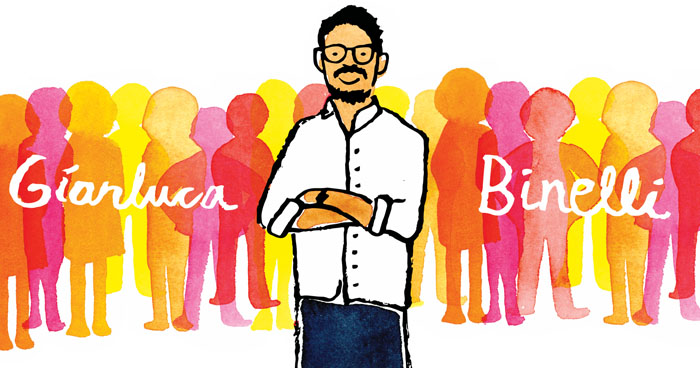
The HR world is flooded with buzzwords, but agile HR is one trend that’s here to stay. And it’s not as complicated as it sounds. Here’s how agile recruitment looks at the ground level.
So what does “agile” even mean?
When you hear the word “agile” in a business setting, it’s usually a reference to the core philosophy developed by a group of unstoppable geeks (er, we mean techies 😉) who got fed up with the classic waterfall method for developing software and set out to create a better, more dynamic approach for getting stuff done.
Agile principles go way back, but it wasn’t until 2001, when the publication of the Agile Manifesto was released, that the idea of “agile” was marked as a movement in its own right.
The manifesto set out the following values for developing software:
- Individuals and interactions over processes and tools
- Working software over comprehensive documentation
- Customer collaboration over contract negotiation
- Responding to change over following a plan
The creators of the manifesto acknowledged that while there is value in the items on the right, the items on the left are simply more important.
How does agile work?
The great thing about agile principles is that they can be applied to almost anybusiness or business function. And according to the data, more and more execs think that’s a pretty swell idea.
A 2017 survey from the Project Management Institute (PMI) found that 92% of executives believe “organizational agility, or the ability to rapidly respond to market conditions and external factors, is critical to business success.”
According to the report, the concept of agile is more than a process or methodology. It’s the ability to:
- Adjust strategies on a continuous basis
- Empower employees to make key decisions on challenging projects
- Respond to ambiguity and uncertainty with flexibility and speed
- View unanticipated change as an opportunity for transformation
Important characteristics for any business, especially now.
The PMI report, carried out in partnership with Forbes Insights, surveyed 506 senior executives from across the globe and found that, when applied to any department, the benefits of agility were worth the time invested:
- 41% of respondents said profits and/or revenue improved because of agility
- 50% credited agility with their ability to be faster to market
- 47% said agility helped them make faster decisions
- And another 47% said agility helped them meet customer expectations
The execs surveyed likely knew that today’s fast-changing game of business would require a different set of rules. The concept of agile simply gave them a blueprint for applying those principles on a practical level.
Agile Recruitment: What’s this stuff look like?
Traditional HR is packed with formalities and riddled with red tape. 🙄
Or, as the authors of Talent Wins: The New Playbook for Putting People First, Ram Charan, Dominic Barton and Dennis Carey quite aptly put it, most talent practices are stuck in the twentieth century. “They were designed for predictable environments, traditional ways of getting work done and organizations where lines and boxes defined how people were managed.”
Not anymore. Agile HR changes the way companies hire, develop and manage their people so that a company’s HR workflows actually align with and support the true rhythm of your business.
But the transition to agile recruitment isn’t easy. Luckily there are a few shining examples of that can help inspire and guide your own transformation.
Atlassian — Go where the talent takes you
“People with different backgrounds have different perspectives about the same problem, and that’s so important to get the best solution for the customer.” — Bruno Sales, Senior Development Engineer, Atlassian
If you spend any amount of time in the tech world, you know Atlassian.
The 2,500+ employee SaaS company created the tech products most other tech products are built on. From Jira to Trello, their products actually embodythe meaning of agile.
You might also know that Atlassian is based in Sydney, Australia, a market that’s extremely short on talent. 😬
Here’s a glimpse into Atlassian’s agile and scalable recruitment strategy that helps them tap top tech talent from Silicon Valley to Bangalore and everywhere in between.
Take the temperature of your talent pool
Atlassian’s agile recruitment process starts with using LinkedIn to test the waters of the global talent pool for the open position at hand. Using LinkedIn’s talent pool reports, Atlassian’s recruiters can pinpoint markets where the supply exceeds the demand.
Once they have the data, they focus on targeted online branding campaigns and recruiter outreach. “That data comes in really handy to help us assess where we should be focusing our energy,” said Atlassian’s head of talent marketing, Devin Rogozinski in an article for LinkedIn.
Target your recruitment marketing tactics
From its 4-star Glassdoor rating to its widely downloaded team playbook, Atlassian’s fortunate to have a stellar employer brand. Still, asking someone to move halfway around the world isn’t always an easy sell.
The hiring team dropped some of their flashier recruitment efforts so they could focus on highly targeted campaigns that speak directly to the applicants they need. For example, their Relocation 101 video has been a big hit with candidates from all over the world.
But importantly, they walk the talk.
As part of their global recruitment push, talent leaders at Atlassian created the ‘Move Happy’ initiative that helps new hires with the entire relocation process from securing their visas to setting up a local bank account and finding the perfect school for your kids.
Use your competition as your recruiting ace-in-the-sleeve
Armed with the right data and marketing material, hiring teams at Atlassian hit Google and LinkedIn looking for competitors who are around the same size and target the people that work for or around them.
“Wherever it might be they relocated from — London, Ukraine, India — I’ll want to find out who are the people they know and the really good companies and organizations to look into,” says senior technology recruiter, Jessica Sechi. This active, agile approach to global recruiting has paid off. Today, more than 40% of Atlassian’s team comes from abroad. And the diversity benefits of that are huge.
Not only do they get a variety of unique, productivity-driving perspectives from all over the world, but the team also managed to boost their female tech hires by astounding 80%. Quite the accomplishment, especially in tech.
It’s no surprise that the company best-known for creating agile products would have such an awesomely agile recruitment process, but it’s important to point out that the results of practicing what they preach seem to be paying off in dividends, too. The company has almost reached $1 billion in annual revenue. 👌
GE — New tricks for faster hires
“Change is in our DNA: We compete in today’s world to solve tomorrow’s challenges. We have endured because we have the determination to shape our own future. Although we’re still on the journey, we’ve made great strides in revamping our strategy, portfolio, global footprint, workforce and culture.” — Jeff Immelt, Former CEO, GE
GE is somewhat of an “old dog” in the business world.
Founded in 1892, the company is now over 125 years old. What’s perhaps a little less known is that GE is also a force in the HR world. In the ’80s and ’90s, former CEO, Jack Welch made plenty of HR headlines with his famous (or infamous, depending on who you ask) “rank and yank” approach to performance management.
But the household name is actively moving away from its classic conglomerate culture, to that of a global tech-driven company fiercely committed to staying relevant. So it’s no surprise the concept of agile has become the core of many of GE’s most transformative efforts, including the integration of RaaS(Recruiting as a Service), the company’s new and improved agile recruiting model.
RaaS consists of four key elements:
1. The Recruiting Scrum Team
Built as a cross-functional team with all the skills necessary to complete any backlog item, they focus on the execution and delivery of 2 to 5-week sprint cycles.
2. The Recruiting Scrum Master
Created as a new role in the recruiting industry, this certified agile coach facilitates the scrum rituals and retros, execution and prioritization of headcount backlog, and shields the team from interruptions during the sprint.
3. The Headcount Owner
This person is responsible for representing all hiring managers on their backlog and setting the priority of each req.
4. Technology
GE’s tech is designed as a one-stop talent platform connecting talent pipelines, skills, technical assessments and headcount backlogs. It also feeds a Kanban board so members of the team can visualize their progress.
“By looking at sub-cycle time for each requisition, we determined that we had a bottleneck with our interview scheduling team in the United States. We then created a project team to build a new automated interview-scheduling tool to reduce this portion of our cycle time, as well as shift headcount to this task in the short term,” reveals Amber Grewal, former Vice President & Global Head of Talent Acquisition at GE.
Amber and her team were able to scale down time to hire from a 15-week cycle to less than 3–6 weeks. That’s 70% faster hiring. 😲
“Basically we took strands of Agile DNA, and embedded it into the RaaS model to deliver higher quality and streamlined hiring,” says Amber.
With agile moves like that, it’s no wonder GE calls itself “The Biggest Implementation of Lean Startup on Earth.”
Waitr — Scalable agility from sourcing to onboarding
“Whether it’s in our product, customer support process, driver assignments, or any other function of our company, I want our entire product suite to be as streamlined as possible.” — Nichole Pahl, Product Manager, Waitr
Waitr is a fast-growing tech company with its own agile recruitment success story.
Instead of entrusting the recruitment, hiring and onboarding process to a team of classically trained HR pros, these processes are owned by Waitr’s Chief Efficiency Addict, a.k.a. Product Manager, Nichole “Coco” Pahl.
But that wasn’t the initial plan.
The shift in strategy came after Valentine’s Day 2016 when the restaurant delivery app massively underestimated the number of customers they’d be getting. “We got our butts handed to us. Our CEO even had to make a public apology. That was the moment we realized we needed to change our process,” Coco painfully recalls.
Coco made it her mission to optimize Waitr’s recruitment and hiring process so that situations like the Valentine’s Day fiasco would never happen again. 💔
Here’s how she did it.
Step 1: Use data to predict your recruitment and hiring cycles
Coco knew they needed to do a better job of predicting their recruitment needs while nurturing their existing talent pool of drivers (a role that comes with a notoriously high turnover rate).
She started using a business intelligence team to predict when Waitr would need to ramp up their hiring efforts — especially around the holidays.
Step 2: Leverage your employer brand
Waitr’s best candidates come from their website.
Rather than relying on job boards where anyone and everyone can apply, Coco and her team leveraged their applicant tracking system (ATS) to create a fully customized career portal on their website.
They set up a sequence of emails that automatically go out to applicants and candidates every time they reach a new stage in the process. “Those alone save our city managers precious time previously spent on copy/pasting,” says Coco.
Step 3: Centralize the process through a scalable ATS
Coco and her team didn’t stop there.
They wanted to create a candidate experience that could be leveraged across every active market. “From the very beginning, our goal was to make the recruitment process as efficient as possible so we knew we needed an ATS that would let us build additional automation features.”
Before revamping their recruitment process, each individual City Manager had their own ad hoc hiring process (a spreadsheet for most, an accordion file for some 😬). Needless to say, it was a very manual process.
“With Breezy, we can automatically create accounts for drivers in our payroll system, shift-scheduling service, driver system, learning management system and automatically order their background check. We can even allow them to self-schedule their own interviews,” explains Coco.
Step 4: Seamless interviewing
Interviewing is an important piece in the hiring puzzle at Waitr.
“One of our biggest competitive advantages is our driver base. We’re proud of the people we hire.” At Waitr, every last candidate gets an in-person interview.
Coco uses her ATS to make sure each City Manager has access to the same interview questions to help them make sure they’re bringing the right candidates on board. They even went above and beyond by automating their employee onboarding process.
“As part of our Breezy initiative, we took our 2-hour long in-person training and assessment course for candidates and moved it to a learning management system, so they could hit the ground running,” says Coco.
Waitr is a great example of how to respond to ambiguity and inefficiency by creating a scalable recruitment system that grows and is optimized, in step with the rest of the business.
The thing about recruitment and hiring is that it doesn’t have to be as complicated as it seems. Breezy is the simple, streamlined ATS that comes with everything you need to make agile recruitment a reality at your company. Want to see for yourself?





